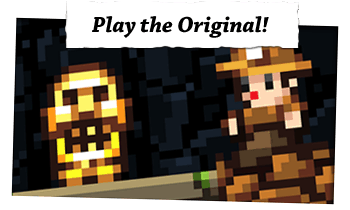Spelunky Classic HD HTML5. HTML5 version of Spelunky Classic HD. This version has a bit more bugs but also it has some nice features: you can play it in your browser; builds for macOS, 64 bits builds for Linux and Windows, ARM builds for Linux (Electron) touch input on any device that supports it (not only android). Spelunky is a cave exploration / treasure-hunting game inspired by classic platform games and roguelikes, where the goal is to grab as much treasure from the cave as possible. Every time you play the cave's layout will be different. Use your wits, your reflexes, and the items available to you to survive and go ever deeper! While Spelunky does a great job of randomizing its levels, there are certain rooms that repeatedly appear. One of the best rooms to find is the snake pit. It’s a high pit that has green and blue snakes protecting a pile of rubies at the bottom. The rubies are nice but the real value here is.
The level is made of 16 rooms in a 4x4 grid. There are 4 different basic room types:
- 0: a side room that is not on the solution path
- 1: a room that is guaranteed to have a left exit and a right exit
- 2: a room that is guaranteed to have exits on the left, right, and bottom. If there's another '2' room above it, then it also is guaranteed a top exit
- 3: a room that is guaranteed to have exists on the left, right, and top
Free cool games you can play at school not blocked on Unblocked Games 6666 Google Sites and don't forget to share with your friends about site.

Spelunky Html5
The first thing it does is place a start room in the top row. Room type doesn't really affect the start rooms, as it's a special case, but generally speaking a start room is type 1 or 2.


Every time a room is placed, at first it is always a type 1 room (left/right).
Then it decides where to go next. It picks a (uniform distribution) random number from 1 to 5. On a 1 or 2, the solution path moves left. On a 3 or 4, the solution path moves right. On a 5, the path goes down. (If the solution path hits the edge of the screen, then it immediately drops down and switches its left/right direction.)
Now here's the thing: if we move left or right, that's all fine and dandy because we've placed down a room with guaranteed left/right exits. But if we've decided to move down, we need to change the room we're in! So the generator overrides the current room to be type 2 (which always has a bottom drop) and we're all good to move down now.
Once it's moved onto the next room, it asks whether the last room we placed was type 2 (bottom drop). If this is true, then this room HAS to be another type 2 bottom drop, or a type 3 upside-down T shape. Since types 2 and 3 have left/right exits, we can start the algorithm all over again.
If we are on the bottom row of room, and we try to drop, instead of dropping down, we place the exit room.
Now we have the entire solution path generated (what's in red above). The last thing we do is we add some random type 0 rooms to every grid space that is not on the solution path. These rooms don't have any guarantees of exits on ANY side, which is why you sometimes see them walled off.
Spelunky Html5 Kbh
If there are 3 or 4 type 0 rooms making a vertical line, then there is a chance that those rooms will become a snake pit. If we decide to make a snake pit, we put down, from top to bottom, a sequence of room type 7 8 9, or 7 8 8 9, depending on the depth of the snake pit we want. (You'll notice that snakes and jewels get placed manually at this point, since they're really part of the landscape and aren't randomly placed like most other enemies.)
That's it! In part 2 I show you how individual rooms get laid out (spikes, ladder/pit formations, etc).